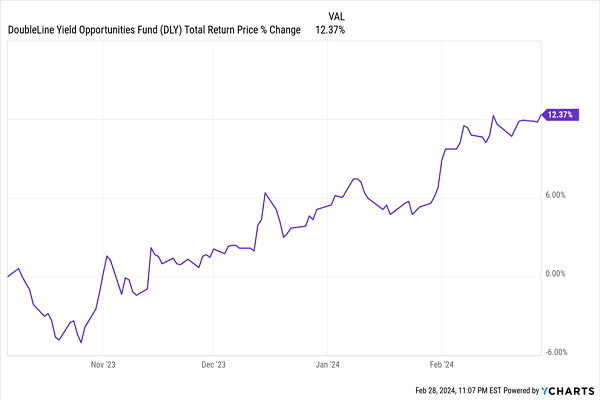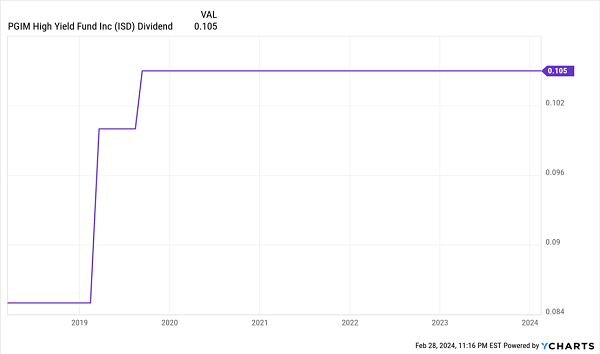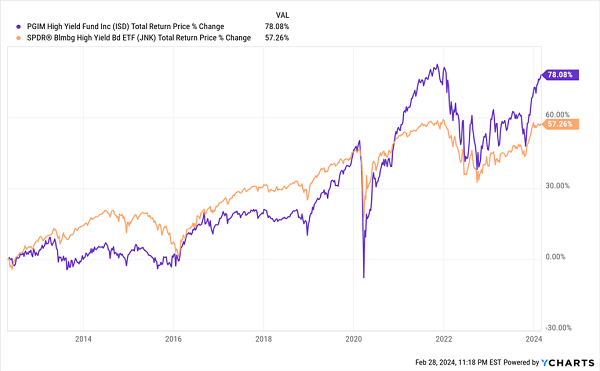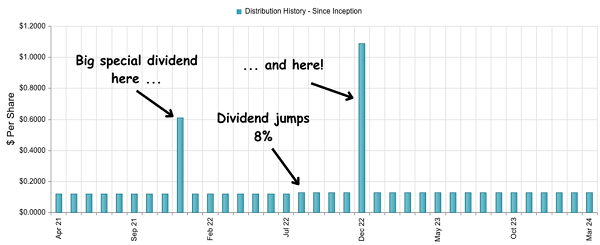Look, this worry that inflation will stick around forever is ridiculously overblown. It’s only a matter of time before it settles out.
Heck, it’s already starting to happen: Last week’s personal consumption expenditures (PCE) print for January—a fav of the Federal Reserve—tells the tale. The headline number came in at 2.8%, as expected. That’s still above the Fed’s 2% target.
But the core number of 2.4% (excluding more volatile categories like food and energy) was the lowest since February 2021.
We looked at one way to profit from overwrought fears last week: low-volatility dividend-payers like utilities and food makers. Many folks see these as “bond proxies.” As such, they’ve been oversold as worries about high inflation and rates made a comeback in recent weeks.
This week we’re going from bond proxies to the real thing, tapping funds that hold top-quality corporate bonds, kick out 9%+ dividends and trade at big discounts to net asset value (NAV, or the value of their underlying portfolios).
Here’s the setup:
- The Fed has rates in restrictive territory, so it’s only a matter of time before the economy cools. As it does, the yield on the trendsetting 10-year Treasury note will fall. In turn …
- Consumer prices will decline, further driving the move to lower rates.
To be clear, we aren’t going back to the bargain-basement rates of the 2010s. Millions of baby boomers have exited the workforce since, leaving us with a demographically driven labor shortage.
In a labor-crimped world (even with AI’s impact), inflation close to, or a bit above, the top of the Fed’s 2% to 3% target window will be the norm. But rates will go lower from here. As they do, bond prices will rise. That’s just how it works.
The bottom line: Today, with its still-high rates but a cooldown around the corner, gives us a nice shot at locking in some healthy bond dividends and set ourselves up for gains, too.
Why March 2024 Is October 2023 Part II
We know this because, well, we’re facing a similar setup to October 2023, when panic was everywhere and the 10-year Treasury yield brushed 5%. Back then, we named the DoubleLine Yield Opportunities Fund (DLY), payer of a 9.5% yield at the time, one of our top portfolio buys in the October issue of my Contrarian Income Report service.
Since then, it’s delivered us a nice 12.4% in gains and dividends:
9.5%-Paying Bond Fund Soared on the Last “Inflation Forever” Scare

That’s the kind of return you can expect when you buy at moments like this. And while we’re not nearly at the panic levels we saw in October, this second chance to buy has still left some cheap bond-CEF deals on the board.
Consider, for example, the PGIM High-Yield Bond Fund (ISD), which yields 9.8% today while trading at a 7% discount to net asset value (NAV, or the value of the bonds it holds.
ISD’s portfolio is made up of 332 bonds, mainly from US firms. Credit quality is mostly in the B to BB range (around 70% of the portfolio), just outside the investment-grade line. We love that because it’s where the best bond bargains lie, as many of the big players are limited to investment-grade paper.
Moreover, ISD’s 9% payout has grown—leaping higher twice in 2019, for a combined 24% hike. That’s key because it came as the Fed was easing off the string of rate hikes it had brought in starting in late 2015—a situation similar to the one we’re seeing today:
ISD’s Dividend Popped the Last Time Rates Rolled Over

What’s more, the fund is run by Prudential, a mainstay of the financial world, so you know management is among the first to get the call when new bonds are issued. Connections count in bond-land, which is why many bond-fund managers regularly beat their benchmarks.
That, by the way, is the case with ISD, which has soared past the benchmark SPDR Bloomberg High Yield Bond ETF (JNK) since inception in 2012:
ISD’s Human Managers Get the Job Done

Finally, a note on that 7% discount. This fund sported a discount of a little more than half that—around 3.4%—in late 2021. That’s a good level for the fund to retake in the coming months as Inflation Panic II cools off, Powell cuts rates and the economy slows, driving up interest in this high-yield bond CEF.
This Top 2024 Bond Pick Pays a Growing 14% Dividend
ISD is worth putting on your watch list for its discount and (of course!) its 10.2% dividend. A payout like that, we all know, can be life-changing: even with, say, $30,000 invested, you can bring in $100 a month in dividends.
And I do mean every month, because as I wrote above, ISD pays dividends monthly.
That’s also the case with another bond CEF I’m pounding the table on now. It’s at the top of our buy list for similar reasons as ISD: a high yield, monthly payouts and savvy management.
But it tops ISD by a long shot on the dividend and management fronts, with a 14% current yield, a monthly dividend, dividend growth and a history of special dividends!
A “Once-in-a-Generation” 14% Dividend Opportunity

Source: CEF Connect
What’s more, that immense payout is delivered by a manager whom Morningstar previously named Fixed Income Manager of the Year. He’s also been inducted into the Fixed Income Analysts Society Hall of Fame.
To say he knows the bond world is an understatement—and now we can get him working for us, just in time to help us navigate the shifting winds we’ll no doubt encounter in the year ahead.
Don’t miss this opportunity, which I’m urging ALL investors to take advantage of now. Click here to learn more about this 14%-yielding income play and get a free Special Report revealing my latest research on it.
Before you make your next trade, you'll want to hear this.
MarketBeat keeps track of Wall Street's top-rated and best performing research analysts and the stocks they recommend to their clients on a daily basis.
Our team has identified the five stocks that top analysts are quietly whispering to their clients to buy now before the broader market catches on... and none of the big name stocks were on the list.
They believe these five stocks are the five best companies for investors to buy now...
See The Five Stocks Here
Wondering what the next stocks will be that hit it big, with solid fundamentals? Enter your email address to see which stocks MarketBeat analysts could become the next blockbuster growth stocks.
Get This Free Report